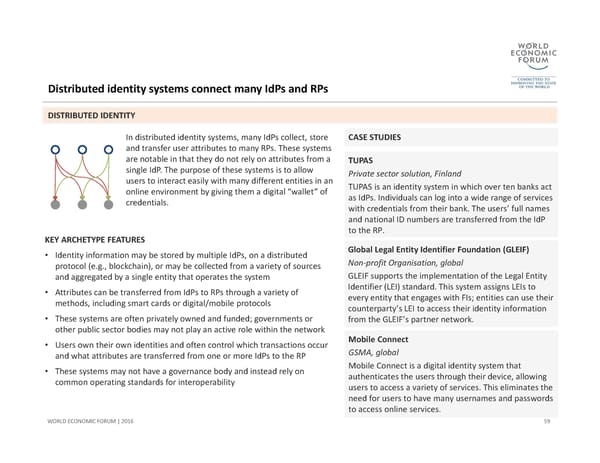Distributed identity systems connect many IdPs and RPs 59 WORLD ECONOMIC FORUM | 2016 KEY ARCHETYPE FEATURES •Identity information may be stored by multiple IdPs, on a distributed protocol (e.g., blockchain), or may be collected from a variety of sources and aggregated by a single entity that operates the system •Attributes can be transferred from IdPs to RPs through a variety of methods, including smart cards or digital/mobile protocols •These systems are often privately owned and funded; governments or other public sector bodies may not play an active role within the network •Users own their own identities and often control which transactions occur and what attributes are transferred from one or more IdPs to the RP •These systems may not have a governance body and instead rely on common operating standards for interoperability In distributed identity systems, many IdPs collect, store and transfer user attributes to many RPs. These systems are notable in that they do not rely on attributes from a single IdP. The purpose of these systems is to allow users to interact easily with many different entities in an online environment by giving them a digital “wallet” of credentials. TUPAS Private sector solution, Finland TUPAS is an identity system in which over ten banks act as IdPs. Individuals can log into a wide range of services with credentials from their bank. The users’ full names and national ID numbers are transferred from the IdP to the RP.Mobile Connect GSMA, global Mobile Connect is a digital identity system that authenticates the users through their device, allowing users to access a variety of services. This eliminates the need for users to have many usernames and passwords to access online services. DISTRIBUTED IDENTITY CASE STUDIESGlobal Legal Entity Identifier Foundation (GLEIF) Non‐profit Organisation, global GLEIF supports the implementation of the Legal Entity Identifier (LEI) standard. This system assigns LEIs to every entity that engages with FIs; entities can use their counterparty’s LEI to access their identity information from the GLEIF’s partner network.
 A Blueprint for Digital Identity Page 59 Page 61
A Blueprint for Digital Identity Page 59 Page 61